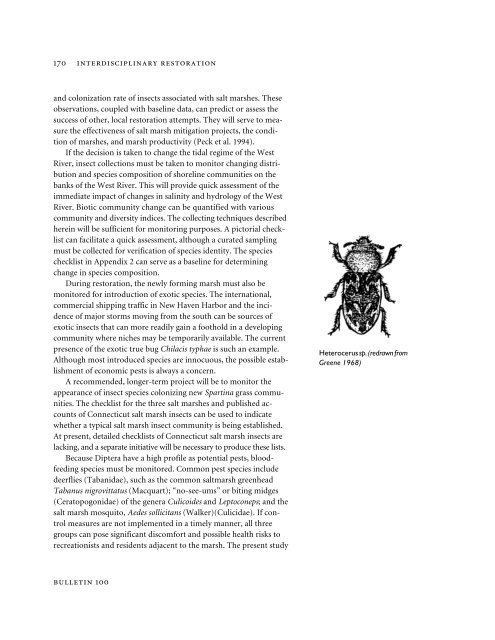Aquatic Insects of the West River and Salt Marshes ... - Yale University
Aquatic Insects of the West River and Salt Marshes ... - Yale University
Aquatic Insects of the West River and Salt Marshes ... - Yale University
You also want an ePaper? Increase the reach of your titles
YUMPU automatically turns print PDFs into web optimized ePapers that Google loves.
170 INTERDISCIPLINARY RESTORATION<strong>and</strong> colonization rate <strong>of</strong> insects associated with salt marshes. Theseobservations, coupled with baseline data, can predict or assess <strong>the</strong>success <strong>of</strong> o<strong>the</strong>r, local restoration attempts. They will serve to measure<strong>the</strong> effectiveness <strong>of</strong> salt marsh mitigation projects, <strong>the</strong> condition<strong>of</strong> marshes, <strong>and</strong> marsh productivity (Peck et al. 1994).If <strong>the</strong> decision is taken to change <strong>the</strong> tidal regime <strong>of</strong> <strong>the</strong> <strong>West</strong><strong>River</strong>, insect collections must be taken to monitor changing distribution<strong>and</strong> species composition <strong>of</strong> shoreline communities on <strong>the</strong>banks <strong>of</strong> <strong>the</strong> <strong>West</strong> <strong>River</strong>. This will provide quick assessment <strong>of</strong> <strong>the</strong>immediate impact <strong>of</strong> changes in salinity <strong>and</strong> hydrology <strong>of</strong> <strong>the</strong> <strong>West</strong><strong>River</strong>. Biotic community change can be quantified with variouscommunity <strong>and</strong> diversity indices. The collecting techniques describedherein will be sufficient for monitoring purposes. A pictorial checklistcan facilitate a quick assessment, although a curated samplingmust be collected for verification <strong>of</strong> species identity. The specieschecklist in Appendix 2 can serve as a baseline for determiningchange in species composition.During restoration, <strong>the</strong> newly forming marsh must also bemonitored for introduction <strong>of</strong> exotic species. The international,commercial shipping traffic in New Haven Harbor <strong>and</strong> <strong>the</strong> incidence<strong>of</strong> major storms moving from <strong>the</strong> south can be sources <strong>of</strong>exotic insects that can more readily gain a foothold in a developingcommunity where niches may be temporarily available. The currentpresence <strong>of</strong> <strong>the</strong> exotic true bug Chilacis typhae is such an example.Although most introduced species are innocuous, <strong>the</strong> possible establishment<strong>of</strong> economic pests is always a concern.A recommended, longer-term project will be to monitor <strong>the</strong>appearance <strong>of</strong> insect species colonizing new Spartina grass communities.The checklist for <strong>the</strong> three salt marshes <strong>and</strong> published accounts<strong>of</strong> Connecticut salt marsh insects can be used to indicatewhe<strong>the</strong>r a typical salt marsh insect community is being established.At present, detailed checklists <strong>of</strong> Connecticut salt marsh insects arelacking, <strong>and</strong> a separate initiative will be necessary to produce <strong>the</strong>se lists.Because Diptera have a high pr<strong>of</strong>ile as potential pests, bloodfeedingspecies must be monitored. Common pest species includedeerflies (Tabanidae), such as <strong>the</strong> common saltmarsh greenheadTabanus nigrovittatus (Macquart); “no-see-ums” or biting midges(Ceratopogonidae) <strong>of</strong> <strong>the</strong> genera Culicoides <strong>and</strong> Leptoconeps; <strong>and</strong> <strong>the</strong>salt marsh mosquito, Aedes sollicitans (Walker)(Culicidae). If controlmeasures are not implemented in a timely manner, all threegroups can pose significant discomfort <strong>and</strong> possible health risks torecreationists <strong>and</strong> residents adjacent to <strong>the</strong> marsh. The present studyHeterocerus sp. (redrawn fromGreene 1968)BULLETIN 100
















